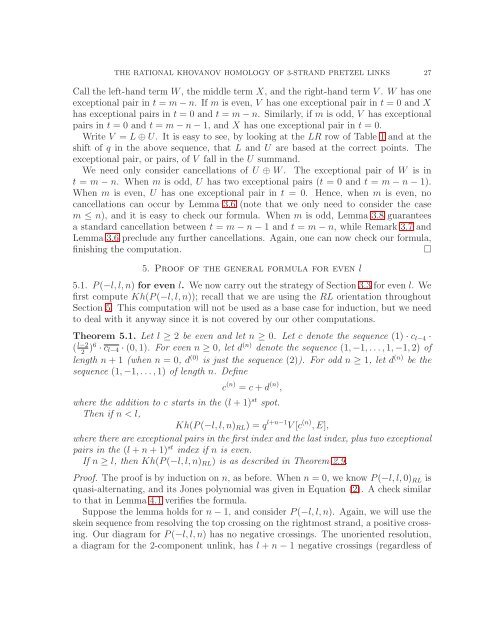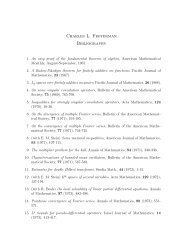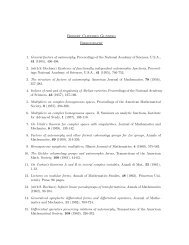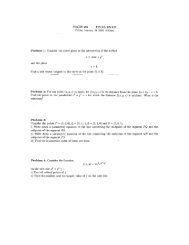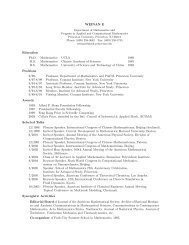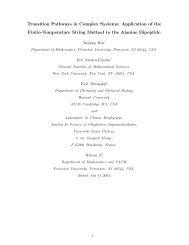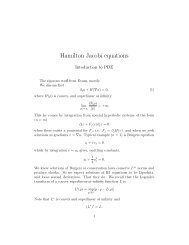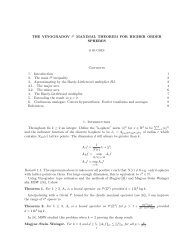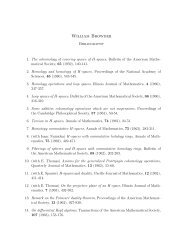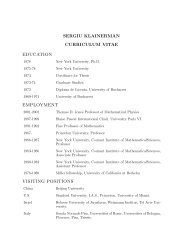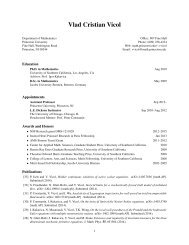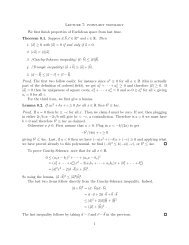The rational Khovanov homology of 3-strand pretzel links
The rational Khovanov homology of 3-strand pretzel links
The rational Khovanov homology of 3-strand pretzel links
Create successful ePaper yourself
Turn your PDF publications into a flip-book with our unique Google optimized e-Paper software.
THE RATIONAL KHOVANOV HOMOLOGY OF 3-STRAND PRETZEL LINKS 27<br />
Call the left-hand term W, the middle term X, and the right-hand term V . W has one<br />
exceptional pair in t = m − n. If m is even, V has one exceptional pair in t = 0 and X<br />
has exceptional pairs in t = 0 and t = m − n. Similarly, if m is odd, V has exceptional<br />
pairs in t = 0 and t = m − n − 1, and X has one exceptional pair in t = 0.<br />
Write V = L ⊕ U. It is easy to see, by looking at the LR row <strong>of</strong> Table 1 and at the<br />
shift <strong>of</strong> q in the above sequence, that L and U are based at the correct points. <strong>The</strong><br />
exceptional pair, or pairs, <strong>of</strong> V fall in the U summand.<br />
We need only consider cancellations <strong>of</strong> U ⊕ W. <strong>The</strong> exceptional pair <strong>of</strong> W is in<br />
t = m − n. When m is odd, U has two exceptional pairs (t = 0 and t = m − n − 1).<br />
When m is even, U has one exceptional pair in t = 0. Hence, when m is even, no<br />
cancellations can occur by Lemma 3.6 (note that we only need to consider the case<br />
m ≤ n), and it is easy to check our formula. When m is odd, Lemma 3.8 guarantees<br />
a standard cancellation between t = m − n − 1 and t = m − n, while Remark 3.7 and<br />
Lemma 3.6 preclude any further cancellations. Again, one can now check our formula,<br />
finishing the computation.<br />
□<br />
5. Pro<strong>of</strong> <strong>of</strong> the general formula for even l<br />
5.1. P(−l,l,n) for even l. We now carry out the strategy <strong>of</strong> Section 3.3 for even l. We<br />
first compute Kh(P(−l,l,n)); recall that we are using the RL orientation throughout<br />
Section 5. This computation will not be used as a base case for induction, but we need<br />
to deal with it anyway since it is not covered by our other computations.<br />
<strong>The</strong>orem 5.1. Let l ≥ 2 be even and let n ≥ 0. Let c denote the sequence (1) · c l−4 ·<br />
( l−2<br />
2 )6 · c l−4 · (0, 1). For even n ≥ 0, let d (n) denote the sequence (1, −1,...,1, −1, 2) <strong>of</strong><br />
length n + 1 (when n = 0, d (0) is just the sequence (2)). For odd n ≥ 1, let d (n) be the<br />
sequence (1, −1,...,1) <strong>of</strong> length n. Define<br />
c (n) = c + d (n) ,<br />
where the addition to c starts in the (l + 1) st spot.<br />
<strong>The</strong>n if n < l,<br />
Kh(P(−l,l,n) RL ) = q l+n−1 V [c (n) ,E],<br />
where there are exceptional pairs in the first index and the last index, plus two exceptional<br />
pairs in the (l + n + 1) st index if n is even.<br />
If n ≥ l, then Kh(P(−l,l,n) RL ) is as described in <strong>The</strong>orem 2.9.<br />
Pro<strong>of</strong>. <strong>The</strong> pro<strong>of</strong> is by induction on n, as before. When n = 0, we know P(−l,l, 0) RL is<br />
quasi-alternating, and its Jones polynomial was given in Equation (2). A check similar<br />
to that in Lemma 4.1 verifies the formula.<br />
Suppose the lemma holds for n − 1, and consider P(−l,l,n). Again, we will use the<br />
skein sequence from resolving the top crossing on the rightmost <strong>strand</strong>, a positive crossing.<br />
Our diagram for P(−l,l,n) has no negative crossings. <strong>The</strong> unoriented resolution,<br />
a diagram for the 2-component unlink, has l + n − 1 negative crossings (regardless <strong>of</strong>


